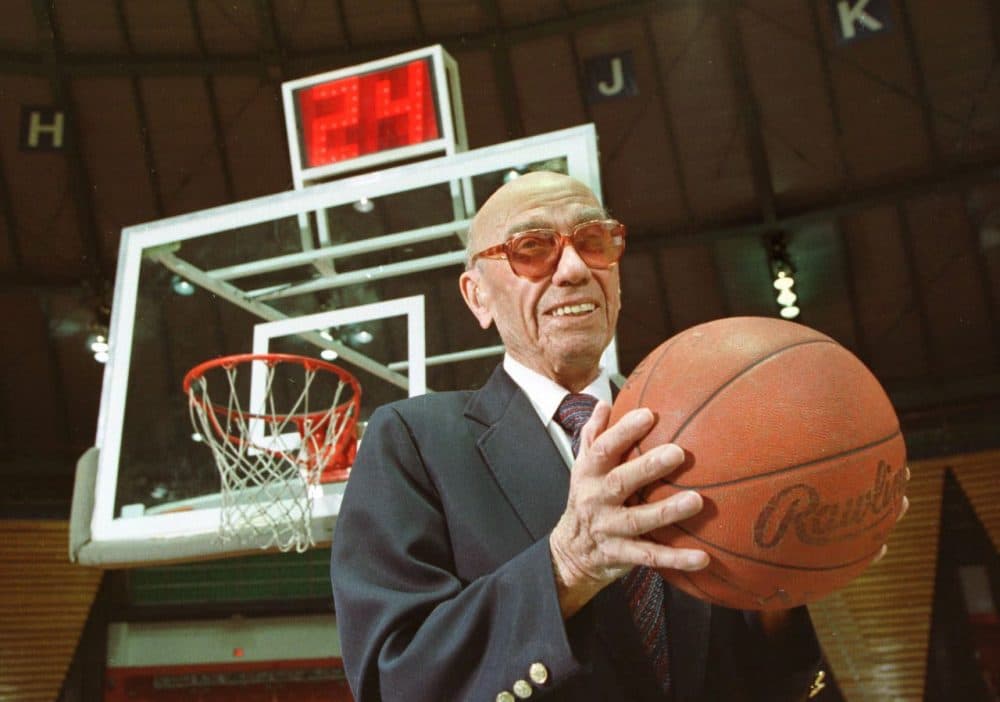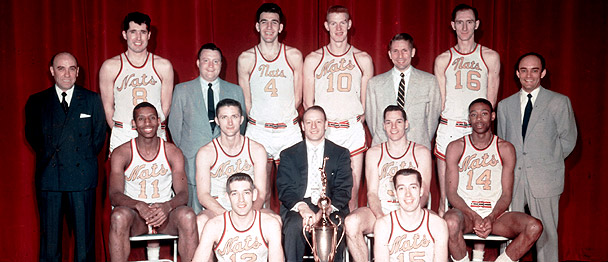Danny Biasone, 1992
October 30, 1954, 70 years ago: The National Basketball Association starts the 1954-55 season, the 1st with the 24-second shot clock. Professional basketball would never be the same.
From their arrival from the rival National Basketball League in 1948 until the retirement of their star center George Mikan in 1954, the NBA was dominated by the Minneapolis Lakers. Although they had others who that would go on to the Basketball Hall of Fame -- forwards Jim Pollard and Vern Mikkelsen, and guard Slater Martin -- their game was mainly to get the ball in to Mikan, at 6-foot-10 the pro game's 1st great "big man," and let him lay it in.
But Mikan was not fast. The New York sportscaster Bill Mazer once said, "He was more like a stampeding elephant." And, unlike some later big men, he was unwilling to foul his way into shooting position, which, for him, wasn't a big area. So the Lakers would keep passing the ball around until Mikan, or somebody else, could get into the lane. This could take several minutes.
The only way to defend against this was to commit fouls, hope that a free throw was missed, and hope that someone could rebound the miss before Mikan could. Or, for the other team to do the same: Hold the ball, pass it around, for as long as possible until someone got inside before Mikan could.
This resulted in scores that even the 1990s New York Knicks version of Pat Riley would think were too low, bottoming out on November 22, 1950: The Fort Wayne Pistons attempted only 13 shots through the entire 48 minutes, and beat the Lakers, 19-18. The 4th quarter saw just 3 points from the Pistons, 1 from the Lakers. A few weeks after that, on January 6, 1951, the Indianapolis Olympians beat the Rochester Royals, 75-73. The final score wasn't the problem. The problem was that game went to 6 overtimes, an NBA record; and, in each overtime, the team that won the jump ball held the ball for nearly the entire 5 minutes before attempting a last-second shot.
The NBA was getting boring. Attendance was dropping. Teams were dropping out. When the NBA was founded as the Basketball Association of America in 1946, it had teams in Washington, Toronto, Chicago, St. Louis, Detroit, Cleveland and Pittsburgh. By the start of the 1951-52 season, all of those teams were gone. Eventually, all of those cities but Pittsburgh would get new teams (although St. Louis eventually lost their replacement, and Chicago lost theirs before a 2nd replacement, the Bulls, succeeded). But big cities were losing teams, because fans didn't want to come out to see the games. Something had to be done.
In 1954, the owner of the Syracuse Nationals, Danny Biasone, had an idea: "I looked at the box scores from the games I enjoyed, games where they didn't screw around and stall. I noticed each team took about 60 shots. That meant 120 shots per game. So I took 2,880 seconds (48 minutes) and divided that by 120 shots. The result was 24 seconds per shot."
Biasone showed his findings to his general manager, Leo Ferris, and his head coach Al Cervi. Cervi ran intrasquad games with a stopwatch, and blew his whistle after 24 seconds without a shot. They agreed that 24 seconds worked well. Ferris talked to the other NBA GMs, and they adopted it for the 1954-55 season, although Biasone has gone down in history as the idea man: He is in the Basketball Hall of Fame, while Ferris is not. (Cervi is in, but was elected for what he did as a player.)
At first, the clock made players nervous. Dolph Schayes, the Nats' best player, said, "We thought we had to take quick shots – a pass and a shot was it – maybe 8–10 seconds... But as the game went on, we saw the inherent genius in Danny's 24 seconds. You could work the ball around for a good shot."
The shot clock, together with some rule changes concerning fouls, revolutionized NBA play. In the last pre-clock season, 1953-54, teams averaged 79 points per game; in the first year with the clock, 1954-55, the average was 93 points, which went up to 107 points by its fourth year in use, 1957-58. The increase in scoring led to an increase in attendance of 40 percent within a few years, to an average of 4,800 per game.
And, wouldn't you know it: The Nationals, the 1st team to work with the shot clock, and thus the team with the most exposure to it, won the 1955 NBA Championship. They got back to the Finals in 1956, but lost to the Philadelphia Warriors. Then Red Auerbach drafted Bill Russell for the Boston Celtics, and they used the shot clock better, and dominated the NBA for the next 13 years.
The 1955 NBA Champion Syracuse Nationals.
Biasone is at far left, Farris at far right, Cervi in the middle.
Number 4 is Hall-of-Famer Dolph Schayes.
The Nationals remained a good team, but Syracuse eventually proved to be too small a market for a major league sports team. In 1963, the Nats moved, becoming the Philadelphia 76ers, taking the place of the Warriors, who had moved to San Francisco a year earlier.
The American Basketball league of 1961-63 used a 30-second shot clock. The American Basketball Association started in 1967, and also used a 30-second clock. To get its teams ready for absorption by the NBA (4 of them were: The New York Nets, the Indiana Pacers, the San Antonio Spurs and the Denver Nuggets), they switched to a 24-second clock for 1975-76, which turned out to be the ABA's last season.
The NCAA resisted putting a shot clock in the college game, but allowed conferences to experiment with it, and some did, with enough success that the NCAA put in a 45-second shot clock in 1985. The college game was already growing in popularity, and the institution of the shot clock increased it. The clock was reduced to 35 seconds in 1995, and 30 seconds in 2015.
Biasone died in 1992, not long after the photo at the top was taken at the Nats' arena, the Onondaga County War Memorial, built in 1951, and now named the Upstate Medical University Arena. It is home to the Syracuse Crunch of the American Hockey League. Ferris died in 1993, Cervi in 2009.
In 1996, ESPN held a panel discussion on what was the greatest team in NBA history. Bob Ryan of The Boston Globe said that the 1954 institution of the shot clock should be a demarcation line. He cited both Mikan and the NBA's 1st scoring champion, the leader of the Warriors who won the 1st NBA title in 1946-47, as players who would not have excelled under the new system: "I'm not gonna kid you, I don't think Jumpin' Joe Fulks makes it in today's NBA, except maybe as a 12th man. George Mikan? A good backup center. He was great in his time, deserved every accolade he ever got. But, today? He's Greg Kite with a hook shot."
(Ryan decided that the best team in league history was the 1986 Celtics. The other panelists chose teams like the 1967 and 1983 Philadelphia 76ers, and the 1987 Los Angeles Lakers. They also discussed the 1965 Celtics, the 1970 New York Knicks, the 1972 Lakers, the 1977 Portland Trail Blazers, and the Chicago Bulls team that had just gone 72-10 and won the title.)
*
October 30, 1954 was a Saturday. There were 3 games played in the NBA on that Opening Day. It would have made sense for the Syracuse Nationals to be among the teams scheduled, but they weren't. The other appropriate teams would have been the Lakers and the Pistons, the teams that played the 19-18 game. And they did:
* The New York Knicks beat the Minneapolis Lakers, 94-83 at the old Madison Square Garden. Without Mikan, no Laker scored more than the 18 of Clyde Lovellette. Carl Braun -- the man whose saying, "Swish!" whenever he hit a shot that hit nothing but net inspired Knick broadcaster Marty Glickman to use it on the air, and later Warner Wolf to do so in WCBS-Channel 2 recaps -- led all scorers in the game with 26. The Lakers moved to Los Angeles in 1960.
* The Fort Wayne Pistons beat the Milwaukee Hawks, 91-72 at the Milwaukee Arena. In 1974, it was renamed the Milwaukee Exposition, Convention Center and Arena, or "The MECCA." Since 2014, it has been named the UW-Panther Arena. This was the 1st professional game for Bob Pettit, who scored 17 points, and went on to become the greatest player in Hawks history. The Hawks moved to St. Louis the next season, and to Atlanta in 1968. The Pistons moved to Detroit in 1957.
* And the Rochester Royals beat the Boston Celtics, 98-95 at the Rochester War Memorial. Like Syracuse's war memorial arena, former arch-rival Rochester's still stands and hosts minor-league hockey, the Rochester Americans, under the name of the Blue Cross Arena. But it does not host pro basketball: The Royals moved to Cincinnati in 1957, to Kansas City as the Kings in 1972, and to Sacramento in 1985.



No comments:
Post a Comment